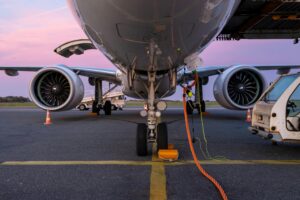Africa’s aviation sector is undergoing a transformative shift, as evidenced by the African Market – May 2025 data from OAG. Total capacity across the continent reached 15.5 million seats, marking a 4.2% increase from May 2024. Within this growth, low-cost carriers (LCCs) emerged as a dynamic force, with capacity surging by 9.4% year-on-year to 2.4 million seats—outpacing the 3.3% growth of mainline carriers, which dominated with an 84% market share. International capacity, representing 68% of the total, rose by 6.6%, while domestic capacity dipped slightly by 0.6%. This article explores the drivers behind the LCC surge, identifies the African countries leading this growth, and offers strategic insights for others to emulate, alongside policy recommendations to sustain and expand this trend. As we unpack these dynamics, we also reflect on the broader implications for Africa’s aviation future.
The 9.4% Surge: A Closer Look at LCC Growth
The 9.4% growth in LCC capacity to 2.4 million seats is a standout statistic in Africa’s aviation landscape. While mainline carriers, which hold the lion’s share of the market, grew at a more modest 3.3%, LCCs are carving out a niche, now accounting for 16% of total operations—up from 9% in 2015, according to historical OAG data. This growth rate, though still below global averages (35%) or regional benchmarks like Europe (44%) and the Middle East (29%), signals a shift toward affordability and accessibility in African air travel. The fact that international capacity drives much of this increase (up 6.6%) suggests LCCs are capitalizing on cross-border demand, while the 0.6% decline in domestic capacity hints at untapped potential within intra-regional markets.
This disparity raises a thought-provoking question: What is fueling the LCC surge, and how can Africa harness this momentum to bridge connectivity gaps while addressing systemic challenges? The answers lie in a combination of market dynamics, operational strategies, and regional variations that are reshaping the continent’s aviation narrative.
Drivers of LCC Growth in Africa
Several interconnected factors are propelling the rise of LCCs in Africa, each reflecting broader trends in global aviation adapted to the continent’s unique context:
1. Demand for Affordable Travel
Africa’s growing middle class and price-sensitive travelers are driving demand for cost-effective air travel. LCCs, with their focus on competitive base fares and ancillary revenue streams (e.g., baggage fees, seat selection), cater to this demographic. The 6.6% increase in international capacity aligns with rising cross-border leisure and business travel, particularly in regions where traditional carriers have historically priced out budget travelers.
2. Operational Efficiency as a Competitive Edge
LCCs thrive on operational simplicity. By maximizing aircraft utilization—often achieving 13-hour daily flight schedules—and employing dense seating configurations, carriers like FlySafair and Air Arabia Maroc reduce per-seat costs. Fleet standardization, typically with narrow-body aircraft like the Boeing 737, further enhances efficiency by simplifying maintenance, training, and spare parts inventory. FlySafair’s 93.82% on-time performance (OTP) in 2024, as reported by Cirium, exemplifies how such strategies translate into reliability and customer trust.
3. Gradual Market Liberalization
The Yamoussoukro Decision (1999), aimed at liberalizing African air markets, has seen slow but steady progress. Regional agreements and bilateral open-skies policies have lowered barriers to entry, allowing LCCs to expand routes and compete with state-protected carriers. This is particularly evident in North and Southern Africa, where international connectivity has flourished. However, the pace of liberalization remains uneven, limiting LCC penetration in some markets.
4. Digital Transformation Post-COVID
The pandemic accelerated digital adoption across industries, and LCCs have capitalized on this trend. Mobile apps, ticketless travel, and self-service kiosks reduce operational costs and enhance customer accessibility. In a continent where smartphone penetration is rapidly increasing, these tools have made air travel more convenient, particularly for younger, tech-savvy travelers who form a core LCC demographic.
Leading the Charge: Which Countries Are Driving LCC Growth?
The growth of LCCs is not uniform across Africa but is concentrated in countries with favorable conditions:
South Africa: A Model of LCC Success
South Africa stands out with a 60% LCC penetration rate in its domestic market (2019 data), driven by carriers like FlySafair and Kulula.com. FlySafair, operating 21 Boeing 737s, has set a regional benchmark with its operational excellence, achieving a 93.82% OTP in 2024. South Africa’s advanced infrastructure—modern airports like Johannesburg (JNB) and Cape Town (CPT), efficient air traffic control, and reliable ground services—creates an enabling environment for LCCs to thrive. The country’s tourism appeal and business hub status further fuel demand.
Morocco: Leveraging Tourism and Connectivity
Morocco, a key player in North Africa, benefits from LCCs like Air Arabia Maroc, which capitalize on the country’s tourism-driven economy. Airports like Casablanca (CMN) and Marrakech (RAK) have seen capacity increases of 9.9% and 5.4%, respectively, reflecting strong inbound demand from Europe. Morocco’s liberal bilateral agreements and proximity to European markets make it an attractive base for LCC operations.
Egypt: A Gateway for Growth
Egypt’s aviation sector, centered around Cairo International Airport (CAI), is another LCC growth hub. With 1,560,047 seats in May 2025 (+3.5%), Cairo serves as a gateway between Africa, Europe, and the Middle East. The country’s stable regulatory environment and investments in airport infrastructure support LCC expansion, catering to both tourist and transit passengers.
Ethiopia: Emerging LCC Dynamics
Ethiopia, while dominated by Ethiopian Airlines (a mainline carrier), is seeing competitive dynamics that bolster LCC growth. Addis Ababa (ADD), with 1,079,272 seats (+10.4%), benefits from its role as a pan-African hub. The rise of regional LCCs or subsidiaries in this market reflects Ethiopia’s strategic focus on connectivity and economic growth.
These countries share common traits: developed infrastructure, regulatory predictability, and markets with high travel demand. However, their success also highlights the disparities that leave other regions, like Central/Western Africa, struggling to keep pace.
Emulating LCC Growth: Strategies for Other Countries
Countries lagging in LCC adoption, such as Nigeria and Ghana, can draw lessons from these leaders to unlock similar growth:
1. Invest in Infrastructure and Secondary Airports
South Africa’s use of secondary airports like Lanseria demonstrates how decongesting primary hubs can lower costs for LCCs. Other countries should prioritize airport upgrades—modernizing facilities, improving air traffic control, and reducing landing fees—to attract LCC investment. Public-private partnerships can accelerate this process, as seen in Ethiopia’s Bole International Airport expansion.
2. Standardize Fleets for Efficiency
Fleet commonality, as practiced by FlySafair with its all-Boeing 737-800 fleet, reduces operational complexity. Countries with diverse airline fleets, like Nigeria, should encourage standardization to improve reliability and reduce maintenance costs, making the LCC model more viable.
3. Leverage Data and Technology
Adopting data-driven tools for scheduling, disruption management, and customer engagement can enhance LCC competitiveness. FlySafair’s use of predictive analytics to pre-empt delays offers a blueprint for others to follow, even at a smaller scale, to improve OTP and customer satisfaction.
4. Focus on Underserved Routes
Expanding point-to-point routes, particularly in international markets, can tap into latent demand. Morocco’s success with European routes shows how targeting high-demand corridors can drive growth. Countries like Kenya or Tanzania could similarly focus on regional routes to boost intra-African connectivity.
Policy Recommendations to Encourage LCC Adoption
Sustained LCC growth requires supportive policies that address structural barriers:
1. Accelerate Market Liberalization
Full implementation of the Yamoussoukro Decision and open-skies agreements can dismantle protectionist barriers, allowing LCCs to enter new markets. Governments should prioritize regional cooperation to create a unified African air market, reducing the regulatory fragmentation that stifles competition.
2. Reduce Operational Costs
High fixed costs—fuel prices, airport taxes, and supply chain expenses—are a major hurdle in Africa. Subsidizing fuel, lowering taxes, and negotiating favorable contracts can make the LCC model more financially viable, encouraging new entrants.
3. Streamline Regulatory Processes
Simplifying licensing and bilateral agreements can attract foreign investment and new carriers. Nigeria, for instance, could benefit from clearer, more predictable regulatory frameworks to counter the instability that deters LCC growth.
4. Promote Tourism and Demand
Marketing campaigns that highlight affordable air travel can stimulate demand, particularly in countries with untapped tourist potential. Ghana, with its cultural heritage, could leverage LCCs to boost inbound tourism, following Morocco’s example.
5. Incentivize Sustainable Practices
Offering tax breaks for fuel-efficient aircraft aligns LCC growth with environmental goals. This not only reduces operational costs but also positions African LCCs as leaders in sustainable aviation, a growing global priority.
A Critical Reflection: Opportunities and Challenges Ahead
While the 9.4% growth of LCCs is encouraging, it must be viewed with a critical lens. The 16% LCC share in Africa remains low compared to global benchmarks, and growth is heavily skewed toward a few countries. The 0.6% decline in domestic capacity suggests that LCCs are not yet addressing intra-regional connectivity effectively, potentially due to infrastructure gaps, high costs, and regulatory protectionism. Moreover, the reliance on international growth raises concerns about vulnerability to global economic shifts—could a downturn in European demand, for instance, stall this momentum?
These challenges highlight the need for a balanced approach. Africa cannot simply replicate European or Middle Eastern LCC models, where market saturation is a growing concern. Instead, it must craft a strategy that accounts for local realities—sparse infrastructure, economic disparities, and regulatory complexities—while leveraging its unique strengths, such as a young, growing population and untapped markets.
A Path to Inclusive Growth
The 9.4% surge in LCC capacity to 2.4 million seats in May 2025 is a beacon of opportunity for Africa’s aviation sector. Driven by demand for affordability, operational efficiency, and gradual liberalization, LCCs are reshaping how Africans travel, with South Africa, Morocco, Egypt, and Ethiopia leading the way. By investing in infrastructure, standardizing fleets, leveraging technology, and adopting supportive policies, other countries can emulate this success, unlocking economic benefits and enhancing connectivity.
Yet, the journey ahead requires careful navigation. Addressing systemic barriers—particularly in underperforming regions like Central/Western Africa—will be critical to ensuring that LCC growth is inclusive and sustainable. As Africa stands at this crossroads, the question remains: will policymakers and industry leaders seize this moment to build a more connected, accessible continent, or will structural challenges continue to limit the LCC revolution’s potential? The data points to a promising future, but the path forward demands bold, collaborative action.
Disclaimer: The insights shared in this article are for informational purposes only and do not constitute strategic advice. Aviation markets and circumstances vary, and decisions should be based on your organization’s specific context. For tailored consultancy, contact info@avaerocapital.com.




